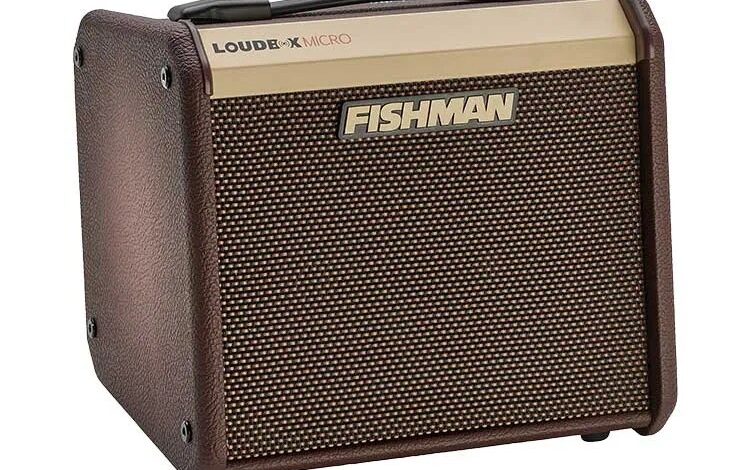Review: Fishman’s Lightweight Loudbox Micro Acoustic Amp Packs a Punch


It was a little hard to imagine that the small box the UPS driver plunked down on my front stoop could contain an amplifier. And unboxed, of course, the thing was even littler: around the size of a four-slice toaster.
The amp in question is a Loudbox Micro, the newest addition to Fishman’s Loudbox line—the Micro’s siblings range from the 60-watt Mini and Mini Charge to the 120-watt Artist and 180-watt Performer. Loudbox amps have become ubiquitous by delivering clear, full-range amplification of acoustic instruments and vocals alike, and the 40-watt Micro is designed to do the same, with the smallest footprint and price tag yet ($299 street).

Ins and Outs
While the Micro is diminutive (9.5 by 10.4 by 8.1 inches) and lightweight (just over nine pounds), Fishman packs plenty into this amp.
Like the other Loudboxes, the Micro offers instrument and mic channels. On the instrument side, you’ve got gain, low/mid/high EQ, reverb, chorus (with mild and heavy presets), and a phase switch to help tame feedback. The mic channel offers just gain, low and high EQ, and reverb. All the controls are easy to understand and use, though at times I found them a bit hard to see, because the amp’s top is angled back and the control panel is recessed on the rear. When the amp was by a wall, for instance, I found myself tipping it forward to make sure I was tweaking the right knob.
On the back are simply a connector for the power adapter, aux input (for, say, playing a track from your phone); a headphone out that allows you to zone out privately to your amplified sound; and an XLR output that can send your mix (post EQ and effects) to a mixer, PA, or recording interface.
Sound Check
I know the amplified sound of my guitars very well from performing and live recording, and when I plugged into the Loudbox Micro, I was greeted by familiar tones right off the bat. My main guitars, a Manzer and a Taylor 712c, are equipped with Fishman Rare Earth Mic Blend systems, and the amp did a fine job representing the mix of internal mic and magnetic pickup. The Rare Earth’s mic can be sensitive for feedback, but even playing close to the amp at a decent volume, I didn’t run into feedback issues unless the soundhole directly faced the speaker.
Whether I fingerpicked, played bluesy lead lines, or dug into percussive strumming, the Micro delivered a clean and detailed sound. When I tuned down to dropped D, or went as low as C on the sixth string, the bass notes remained rich and full. The amp’s hall-type reverb brought appealing spaciousness to the guitar. While I don’t typically use chorus, I found a mild touch of this effect added a nice shimmer.

I plugged in a Taylor GS Mini as well, again with good results and minimal tweaking needed, and my Strumstick—a three-string dulcimer-type instrument—sounded fantastic. The Micro seems ready to handle whatever pickup-equipped acoustic instrument you might want to send its way.
On the mic side, I set up a Shure SM58 and quickly dialed in a satisfying vocal and guitar mix. Tone controls on the mic channel are limited but do the job. It’s worth noting that you can use a balanced signal from an outboard preamp in the mic channel—to plug in a second instrument, for instance. I tried guitar in the mic channel via a passive Radial ProDI and a Fishman Platinum ProEQ DI, and both worked well.
As for volume, the Micro is plenty loud enough to fill a small room (and to send my dog fleeing to the other end of the house), though you’d likely want more power for larger and noisier spaces.
I compared the Micro’s output to that of my Roland AC-60, an amp with considerably more wattage and capabilities, and just for basic tone, the Micro held its own—despite being roughly half the size, weight, and price.
In Practice
Fishman labels the Micro a practice amp, and no doubt it would be great for the woodshed—allowing you to hone your plugged-in sound and vocal/guitar balance, or to hear yourself better when rehearsing with a band. Using the aux in, you can also practice along with a track.
The amp has many other possible uses, though. It could serve as a tiny PA for a solo house concert or small gig, especially elevated for better dispersion. For a bigger space, you could use the Micro as a personal mixer/monitor and send the line out to the house PA. I tested this capability by feeding the amp mix to a QSC K8.2 powered speaker—that’s a super small combo with a lot of power. I also checked out recording the amp output through my UAD Apollo interface, which could be useful for quickly capturing your live mix.
The Micro lacks features you may want in an amp, such as phantom power for a condenser mic, Bluetooth, battery operation, and an effects loop. And of course you may need more watts. Other Loudbox models offer these capabilities, as do many acoustic amps from other companies. But if you’re looking for good amplified sound in an extremely compact and budget-friendly package, the Loudbox Micro may give you just what you need.
This article originally appeared in the May/June 2024 issue of Acoustic Guitar magazine.



